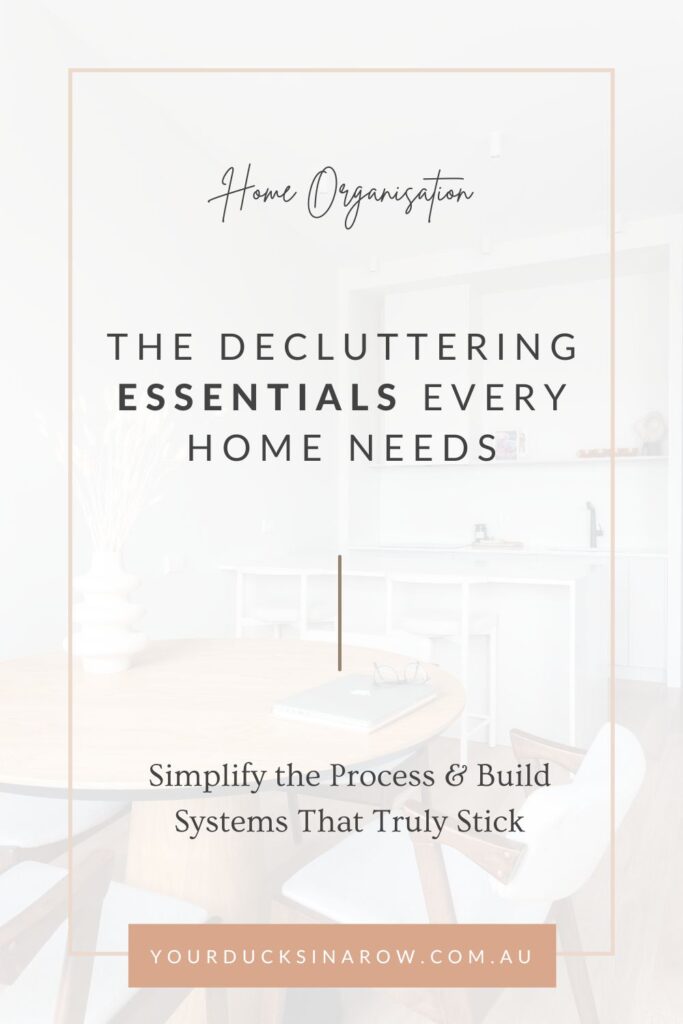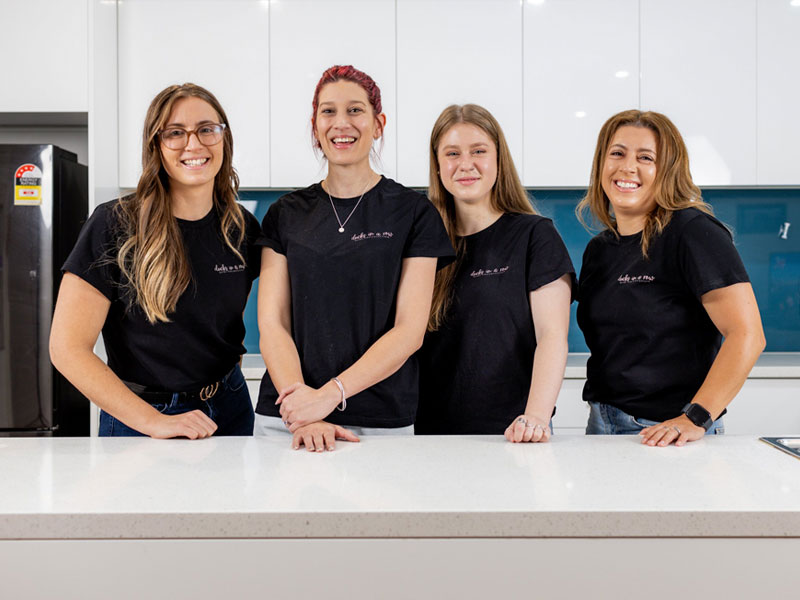Let’s talk about decluttering essentials – your go-to tools and must-haves for getting organised.
If you’ve ever stood in the middle of a messy room thinking, “Where do I even begin?” – you’re not alone. Decluttering your home doesn’t just take motivation, it also helps to have the right tools to make the process smoother, more efficient, and (dare we say it?) even a little fun.
While no product can do the hard decisions for you, the right decluttering essentials can simplify the process, help you stay focused, and ensure that the organising systems you put in place are easy to maintain long after the big clean-out is done.
So whether you’re just getting started or want to upgrade your home organising toolkit, here are the decluttering essentials every home needs.

-
Donation Bags or Boxes
Before anything else, you’ll need a place to put items that are leaving your home. Large, durable bags or boxes make it easy to separate out donations, recycling, and rubbish as you go.
Label each container clearly and keep them nearby as you work through your home. Here are the four essential categories to set up:
- Donate: This is for gently used items that no longer serve you but could be valuable to someone else. Think clothes that don’t fit, books you’ve already read, or kitchen gadgets collecting dust.
- Sell: Have items that are in good condition and might be worth a little cash? Set them aside to sell online through platforms like OLX, Facebook Marketplace, or a local garage sale.
- Recycle: Not everything that leaves your home has to end up in landfill. Old papers, electronics, glass jars, or plastic containers might be recyclable. Keep a separate bin for these items and be sure to follow your local recycling guidelines.
- Rubbish: Some things are just at the end of their life cycle, broken items, worn-out clothes, or things too stained or damaged to donate or recycle. These go straight into the rubbish. Be ruthless here. If it’s not usable or repairable, it’s time to let it go.
Having these categories ready from the beginning helps streamline your decisions and keeps your space from becoming a bigger mess during the process.
Pro Tip: Reuse grocery bags or cardboard delivery boxes to save money and keep your decluttering process eco-friendly.
-
A Label Maker
Once you’ve decluttered, clear labelling is what keeps your home organised over the long term. Labels let everyone in the family know where things belong, making it easier to put things away and maintain tidy systems.
We recommend:
- Brother P-Touch: Affordable, simple, and easy to use. Great for classic, block-text labels that won’t damage surfaces when removed.
- Phomemo D30: Compact, connects via Bluetooth to your phone, and perfect for quick, fuss-free labelling.
- Cricut Joy: Ideal if you want custom fonts and stylish designs. It’s on the pricier side but makes beautiful labels that double as decor.
Pro Tip: Choose a label maker that allows for font customisation or emojis to make it more fun and personal, especially when organising kids’ room or playroom.
-
Storage Bins and Baskets
Once you’ve reduced what you own, proper storage is key to keeping what’s left tidy. Clear bins let you see contents at a glance, while baskets help soften the visual clutter and make your space look polished.
Look for:
- Stackable clear bins with lids for cupboards and pantries
- Open baskets for everyday items like toys, shoes, or throws
- Small drawer organisers for bathroom and kitchen items
Choose a combination of visibility and style to suit the function and aesthetic of each room.
Pro Tip: Use colour-coded baskets for different family members or tasks to make sorting and accessing easier.
-
A Notepad or Decluttering Checklist
Never underestimate the power of a pen and paper. A checklist keeps you focused, helps break large jobs into smaller tasks, and gives you the satisfaction of ticking things off as you go.
You can also jot down:
- Items to sell or donate
- Measurements for storage purchases
- Notes about what zones still need work
Bonus: We offer a free printable decluttering checklist to get you started. It covers every room and makes your next decluttering day feel more manageable.
Pro Tip: Laminate your checklist or use a reusable whiteboard version to track weekly or monthly maintenance tasks.
-
A Timer
Decluttering can be mentally and emotionally draining, so setting a timer can help you stay on track without getting overwhelmed.
Try the “20-minute tidy” method: Set a timer and see how much progress you can make in a short burst. It turns the task into a challenge and helps you build momentum, especially if you’re short on time.
Pro Tip: Use a visual timer for children or family activities to make the process interactive and engaging for everyone.
-
Sticky Notes or Temporary Labels
While you’re in the middle of decluttering, use sticky notes or masking tape to temporarily label categories or zones. This helps during the sorting and setup phase before you finalise your storage and labelling systems.
They’re also useful for families. You can label shelves, baskets, and containers as placeholders until you’re ready to commit to a more permanent solution.
Pro Tip: Use colour-coded sticky notes for different rooms or priority levels. It adds clarity and makes large projects feel more manageable.
-
Measuring Tape
Before you rush off to buy any storage solutions, measure first. There’s nothing worse than excitedly bringing home a new set of drawers only to find they don’t fit the cupboard or don’t maximise the space properly.
Measure:
- Cupboard heights
- Shelf depths
- Drawer widths
- Available floor space
This step will save you time, money, and frustration, and it ensures every item you bring in supports your home organising goals.
Pro Tip: Keep a note in your phone with common household measurements for quick reference when shopping.
-
Heavy-Duty Cleaning Supplies
Decluttering is the perfect time to give your spaces a good clean. Once shelves are empty and drawers are cleared, take the opportunity to wipe everything down.
Basic supplies you’ll want on hand:
- Microfiber cloths
- Multipurpose cleaner
- Disinfecting wipes
- Vacuum or broom
You’ll feel extra satisfied when your newly decluttered space is also sparkling clean.
Pro Tip: Add a fresh scent (like lemon or lavender) to your cleaning products to associate decluttering with positive sensory feedback.
-
Digital Decluttering Tools
Let’s not forget about digital clutter. Use free or low-cost apps to organise your photos, delete old files, or sort digital documents.
For paper clutter, a scanner app can help digitise important files so you can toss the hard copies and reduce physical clutter in your home office or kitchen drawers.
Recommended Apps:
- Google Photos or Apple Photos for backups and organisation
- Evernote or Notion for storing digital notes
- Adobe Scan or CamScanner for digitising paperwork
Pro Tip: Set a monthly digital decluttering reminder to keep your inbox, phone storage, and file folders in check.
-
A “Maybe” Box
Struggling with decision fatigue? Create a “maybe” box where you place items you’re unsure about. Label it with the date and store it out of sight.
If you haven’t needed or missed the items in six months, it’s probably safe to donate or toss them. This gives you peace of mind while helping you build stronger decluttering habits.
Pro Tip: Use a clear box so you can easily see what’s inside and are less tempted to reopen it too often.
So, is it worth it? Absolutely. Here’s why.
Research shows that a clutter-free home can reduce stress, ease symptoms of anxiety and depression, boost your focus, and increase feelings of happiness and contentment. On a day-to-day level, less clutter means fewer decisions, a smoother routine, and more energy for the things that really matter.
Whether you’re overwhelmed by paperwork, drowning in toys, or just tired of spending your weekend searching for things you know you own (somewhere), this practical guide will walk you through the process, one step, one room, one decision at a time. No judgment. No perfection required. Just real strategies that work in real homes with real people.
From Overwhelmed to In Control!
Decluttering doesn’t have to be overwhelming, and it doesn’t require a complete lifestyle overhaul. With the right tools and a thoughtful process, you can transform cluttered chaos into calm, organised spaces.
These essentials are the foundational tools that every home organiser swears by. Whether you’re tackling the garage, kitchen, wardrobe, or your entire home, having a few smart supplies on hand can make all the difference.
Remember: it’s not about perfection. It’s about creating a home that works for your life, one room, one drawer, one label at a time.
Book your FREE consult with our Lead Organiser today!
Show us your space, ask all your questions, and discover how we can transform your home. We’ll walk you through our process and provide a personalised quote – no pressure, just possibilities! Book your consultation here.
Want more tips like these?
Follow us on Instagram (@yourducksinarow) for daily inspiration, behind-the-scenes organising stories, and bite-sized decluttering challenges you can do in under 10 minutes.


